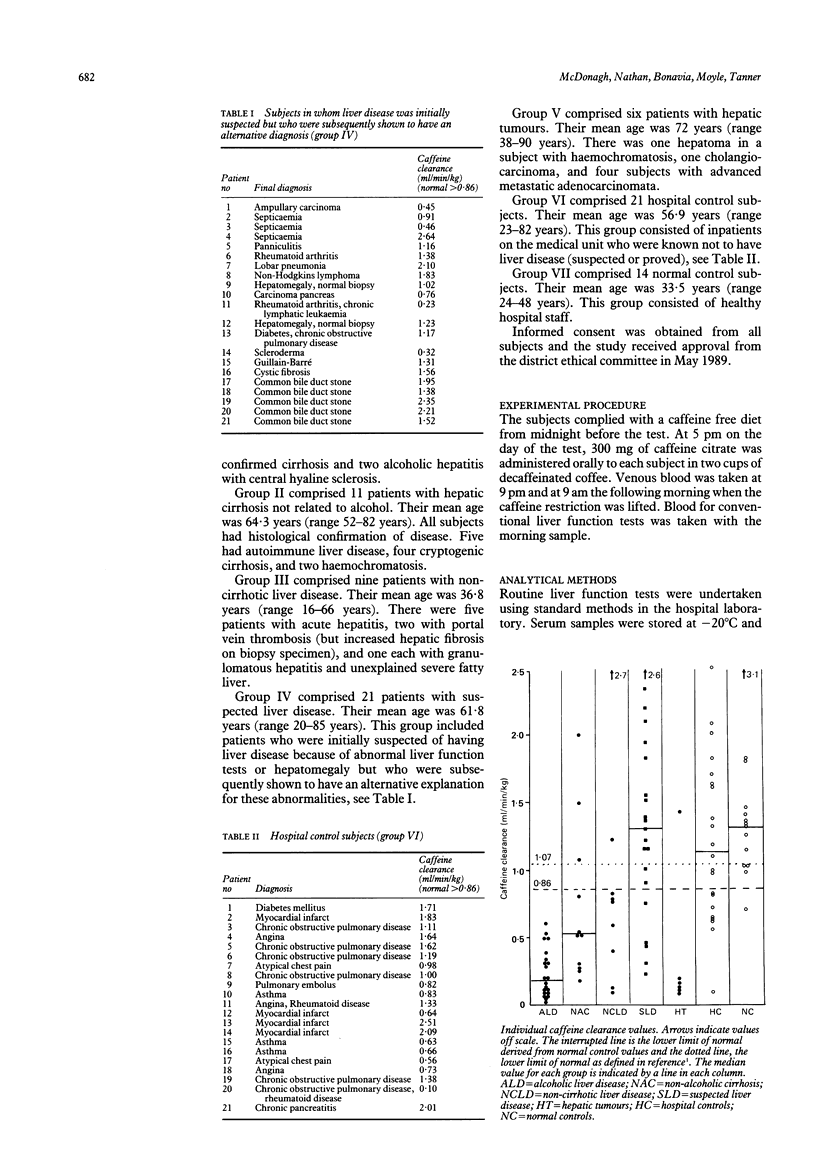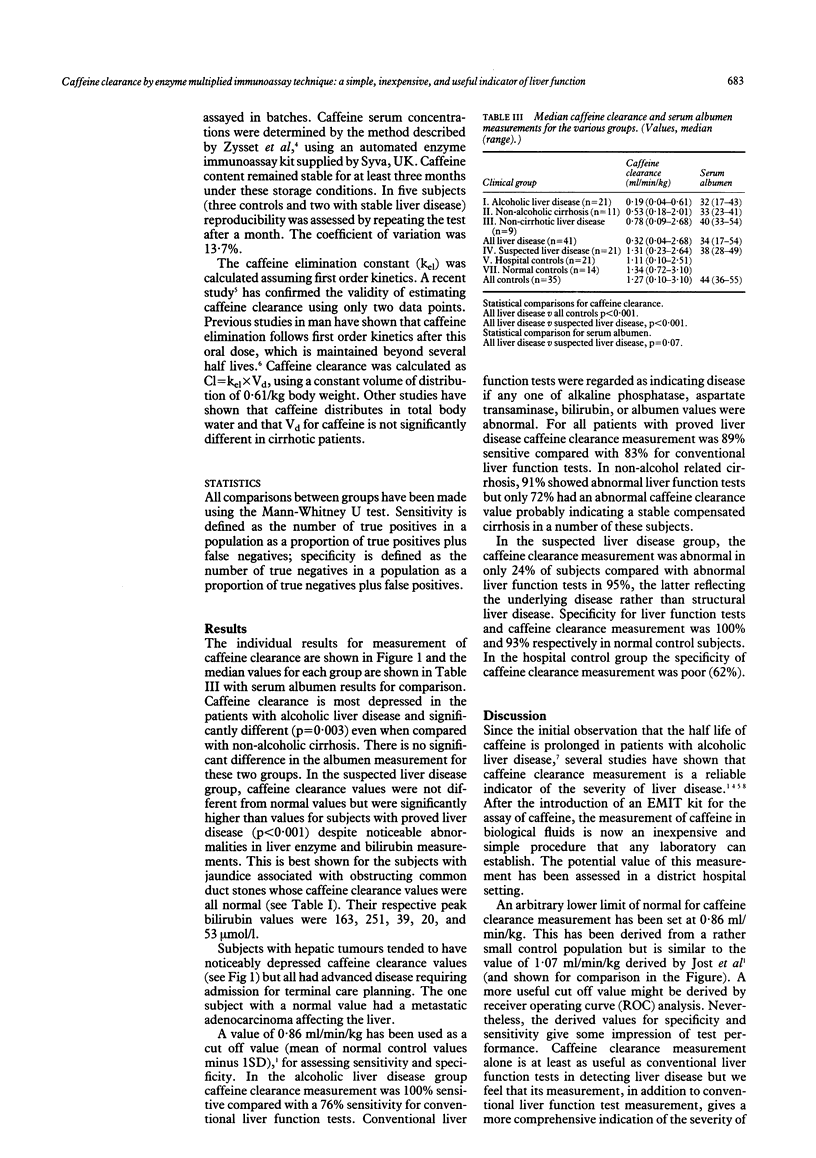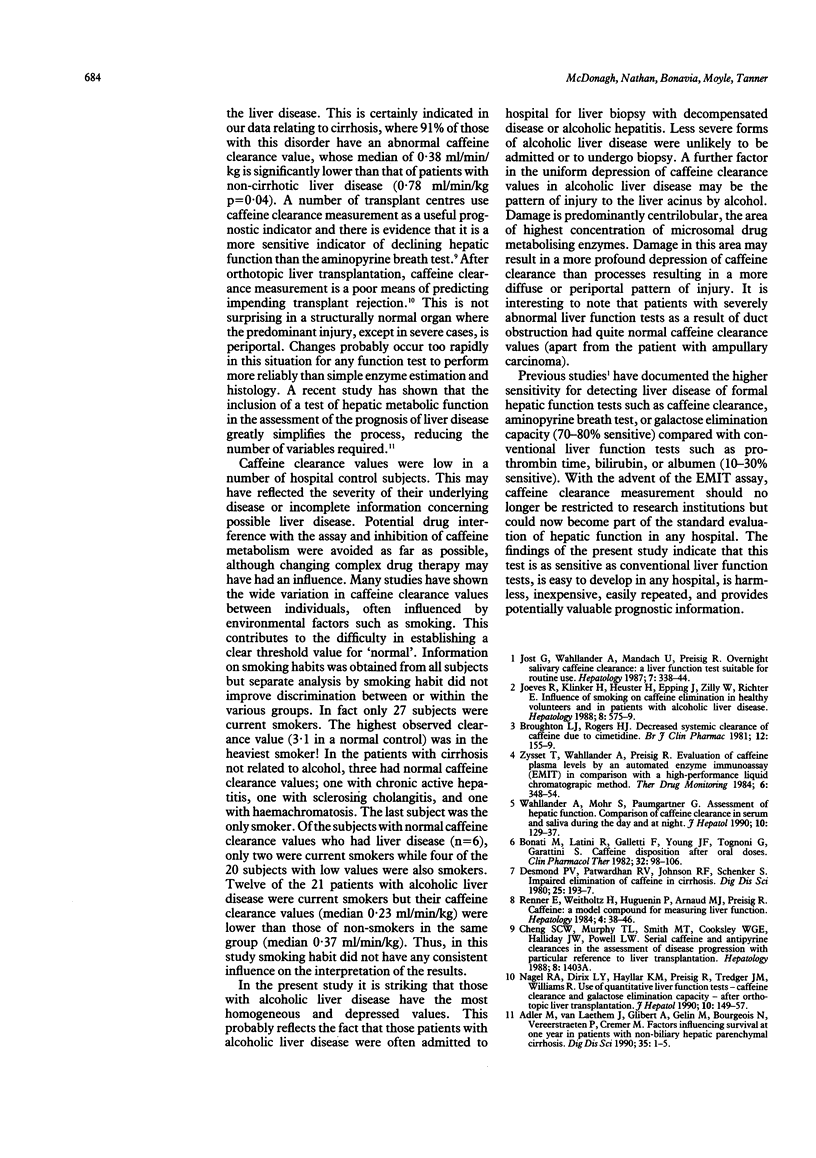Abstract
The clinical value and sensitivity of serum caffeine clearance measurement has been evaluated as an indicator of hepatic disease. After a 17 hour caffeine exclusion period, 300 mg of caffeine citrate was administered orally to the study subjects. Serum samples were taken four and 16 hours later. Serum caffeine concentrations were measured using an enzyme multiplied immunoassay technique (EMIT) and a clearance value derived. Conventional liver function tests were measured at the same time. A total of 103 subjects attending the medical unit in a district general hospital were studied. Twenty one had alcoholic liver disease, 11 non-alcoholic cirrhosis, nine non-cirrhotic liver disease, 21 suspected liver disease, six hepatic tumours, and 35 were hospital and normal control subjects. Caffeine clearance values were lowest in subjects with alcoholic liver disease (median 0.19 ml/min/kg, range 0.04-0.61 ml/min/kg) and significantly reduced in all subjects with liver disease (median 0.32 ml/min/kg, range 0.04-2.68 ml/min/kg) compared with control subjects (median 1.27 ml/min/kg, p less than 0.001). In subjects with suspected liver disease subsequently shown to have another explanation for abnormal liver function test results, caffeine clearance values were normal (median 1.31 ml/min/kg, range 0.23-2.64 ml/min/kg) and significantly different, p less than 0.001, from those of subjects with liver disease. Serum albumen values were not different for these latter two groups. Using a cut off value of 0.86 ml/min/kg, caffeine clearance measurement was 100% sensitive for alcoholic liver disease and 89% sensitive for all liver disease. The respective sensitivities for conventional liver function test measurement were 76% and 83%. In the suspected liver disease group, caffeine clearance was abnormal in only 24%, conventional liver function tests were abnormal in 95%. The respective specificities for caffeine clearance and liver function test measurement in control subjects were 93% and 100%. Caffeine clearance determined by EMIT is a simple inexpensive hepatic metabolic function test. This study indicates that it is a more sensitive indicator of structural liver disease than conventional liver function tests, especially for alcoholic liver disease. The test could be widely introduced as a useful, repeatable assessment of hepatic function.
Full text
PDF



Selected References
These references are in PubMed. This may not be the complete list of references from this article.
- Adler M., Van Laethem J., Glibert A., Gelin M., Bourgeois N., Vereerstraeten P., Cremer M. Factors influencing survival at one year in patients with nonbiliary hepatic parenchymal cirrhosis. Dig Dis Sci. 1990 Jan;35(1):1–5. doi: 10.1007/BF01537214. [DOI] [PubMed] [Google Scholar]
- Bonati M., Latini R., Galletti F., Young J. F., Tognoni G., Garattini S. Caffeine disposition after oral doses. Clin Pharmacol Ther. 1982 Jul;32(1):98–106. doi: 10.1038/clpt.1982.132. [DOI] [PubMed] [Google Scholar]
- Broughton L. J., Rogers H. J. Decreased systemic clearance of caffeine due to cimetidine. Br J Clin Pharmacol. 1981 Aug;12(2):155–159. doi: 10.1111/j.1365-2125.1981.tb01194.x. [DOI] [PMC free article] [PubMed] [Google Scholar]
- Desmond P. V., Patwardhan R. V., Johnson R. F., Schenker S. Impaired elimination of caffeine in cirrhosis. Dig Dis Sci. 1980 Mar;25(3):193–197. doi: 10.1007/BF01308138. [DOI] [PubMed] [Google Scholar]
- Joeres R., Klinker H., Heusler H., Epping J., Zilly W., Richter E. Influence of smoking on caffeine elimination in healthy volunteers and in patients with alcoholic liver cirrhosis. Hepatology. 1988 May-Jun;8(3):575–579. doi: 10.1002/hep.1840080323. [DOI] [PubMed] [Google Scholar]
- Jost G., Wahlländer A., von Mandach U., Preisig R. Overnight salivary caffeine clearance: a liver function test suitable for routine use. Hepatology. 1987 Mar-Apr;7(2):338–344. doi: 10.1002/hep.1840070221. [DOI] [PubMed] [Google Scholar]
- Nagel R. A., Dirix L. Y., Hayllar K. M., Preisig R., Tredger J. M., Williams R. Use of quantitative liver function tests--caffeine clearance and galactose elimination capacity--after orthotopic liver transplantation. J Hepatol. 1990 Mar;10(2):149–157. doi: 10.1016/0168-8278(90)90044-r. [DOI] [PubMed] [Google Scholar]
- Renner E., Wietholtz H., Huguenin P., Arnaud M. J., Preisig R. Caffeine: a model compound for measuring liver function. Hepatology. 1984 Jan-Feb;4(1):38–46. doi: 10.1002/hep.1840040107. [DOI] [PubMed] [Google Scholar]
- Wahlländer A., Mohr S., Paumgartner G. Assessment of hepatic function. Comparison of caffeine clearance in serum and saliva during the day and at night. J Hepatol. 1990 Mar;10(2):129–137. doi: 10.1016/0168-8278(90)90041-o. [DOI] [PubMed] [Google Scholar]
- Zysset T., Wahlländer A., Preisig R. Evaluation of caffeine plasma levels by an automated enzyme immunoassay (EMIT) in comparison with a high-performance liquid chromatographic method. Ther Drug Monit. 1984;6(3):348–354. doi: 10.1097/00007691-198409000-00016. [DOI] [PubMed] [Google Scholar]


